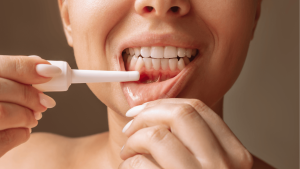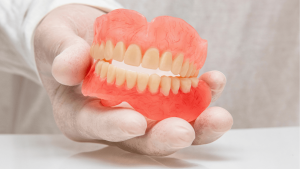Ever notice your gums bleeding a little when you brush? Maybe you have ignored it and are thinking it’s no big deal. But here’s a reality check. Those early signs might be your gums whispering a warning. And if you brush it off (pun intended), it could turn into something bigger: periodontitis. This isn’t meant to scare you. It’s more like a heads-up from a friend. Gums don’t just get mad for no reason, and catching the problem early can save you a lot of pain (and money). In this blog, we will talk about what periodontitis really is and how to spot it before it gets serious. We will also discuss why it happens in the first place and the treatments dentists actually use to fix it.

What Periodontitis Really Means
Think of periodontitis as gum disease that’s leveled up. It starts innocently enough, usually as gingivitis, where your gums are a bit red or swollen. But if bacteria hang around too long, they start attacking the bone that holds your teeth in place. That’s periodontitis.
Believe it or not, it affects way more people than you’d expect. According to the CDC, nearly 47% of adults over 30 in the U.S. have some form of gum disease. And it’s not just about your teeth; untreated gum disease has been linked to heart problems and diabetes, too.
Your gums and your overall health are more connected than you might guess.
How Do You Know If You Have Got It?
Sometimes it sneaks up on you. One day everything feels fine, the next you notice something’s off. Watch out for these clues:
- Gums that bleed when you brush or floss. (And no, that’s not “normal.”)
- Gums that are tender or puffed up.
- Bad breath that just won’t quit, even after brushing.
- Your gums might start to shrink back, so your teeth look longer.
- You might notice your teeth wobbling a bit or your bite just feels off.
- Pus (yes, really) between your teeth and gums.
Even if you are brushing every day, you can still get periodontitis. It’s not just about brushing. It’s about bacteria that settle deep below the gumline.
How Does This Even Happen?
It’s easy to think, “I brush twice a day, so I’m safe.” But the plaque is sneaky. When it sits on your teeth too long, it hardens into tartar. And tartar? You can’t just brush that off; only a dental professional can remove it. A few common culprits:
- Poor brushing and flossing habits.
- Smoking? Big no-no for your gums.
- Got diabetes or other health problems? That ups the risk, too.
- Sometimes it’s just in your DNA; family history matters.
- Hormonal changes (pregnancy and menopause).
- Some medications cause your mouth to become dry.
And stress, believe it or not, can make things worse by weakening your immune system.
How Dentists Tackle Periodontitis (Treatment Options)
Dentists and periodontists have solid ways to treat it. The way dentists handle it changes depending on how far it’s gone.
Deep Cleaning
This isn’t your usual dental cleaning. It is a super scrub that removes tartar and smooths the root surfaces so bacteria can’t easily come back. It also helps your gums reattach to your teeth. It is key to stopping further damage.
Antibiotics
Dentists prescribe antibiotics to kill stubborn bacteria. These can reduce infection and inflammation. It gives your gums a better chance to heal naturally.
Surgery
If the damage is deep, then flap surgery might be needed to clean under the gums. Bone or tissue grafts can help rebuild lost support. Surgery may sound scary, but it’s often the most effective way to save teeth that are at risk of falling out.
Ongoing Maintenance
Even after treatment, you will need regular checkups and cleanings every few months. Periodontitis is one of those “once you have had it, you have to watch it” conditions. Sticking to a maintenance plan greatly lowers the chance of it coming back.
Progression Stages of Gum Disease
Before things get too serious, it helps to see how gum disease progresses step by step. Here’s a quick snapshot of each stage and what to watch out for:
| Stage | What’s Happening | What You Notice |
| Gingivitis | Gums are inflamed, but the bone is intact | Inflamed gums with bleeding |
| Early Periodontitis | Bone begins to break down | Mild gum recession |
| Moderate | Infected spaces deeper below the gumline | Bad breath and loose teeth |
| Advanced | Severe bone loss | Teeth could become misaligned or be lost |
Ways to Stop It Before It Starts
Preventing it early is simpler and less painful than dealing with treatment afterward. There are the following ways through which it can avoid:
- Brush twice a day with fluoride toothpaste.
- Floss (yes, daily, don’t skip it).
- Book professional cleanings every six months, or more if your dental professional recommends.
- Try to quit smoking for better oral health.
- Eat a balanced diet, vitamin C and calcium matter more than you’d think.
And if you are wondering: mouthwash can help, but it’s not a magic fix. It’s like the sidekick, not the hero.
Conclusion
Periodontitis isn’t just bleeding gums. It is a serious condition that causes issues with both your smile and overall health. Catching it early means it’s easier to manage. Don’t wait until your teeth feel wiggly; if something feels off, get it checked. Want to give your gums the attention they deserve? Popup Smiles can connect you with trusted dental professionals who will guide you through prevention, treatment, and long-term care. Both you and your smile will thank you later.
FAQs
Can periodontitis come back after treatment?
Yes, if you slack on oral hygiene or skip dental visits. Regular dental visits are mandatory.
Do electric toothbrushes offer better protection against gum disease?
Studies show electric brushes can remove more plaque, which lowers your risk.
Can gum disease occur without any pain?
Not always do many people have no pain until it’s advanced. That’s why regular checkups matter.






